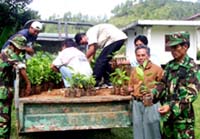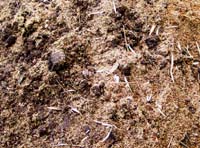|
|
|
|
 |
|
How the Toraja project works
 |
 |
 |
The army, police, and youth volunteers from the church assisted local people to prepare dig holes and plant 4200 trees |
Start of the project
The project began with a conservation workshop in December 2001 attended by community faith representatives, local traditional leaders, government and university representatives. Following this the Toraja Church appointed an official environmental officer, supported by four field supervisors, to run a bio-diversity awareness programme encouraging mixed planting and the production of organic fertiliser. The overall aim was to integrate religious and traditional values with forest and bio-diversity conservation.
Workshop
 |
 |
 |
Bokashi, organic fertiliser generated in the villages, from animal dung mixed with vegetables and other organic material |
At a training centre in Sangkaropi Village a second workshop was held in October 2003 for ten representatives from each village. The training linked cultural and religious values and environmental responsibilities to practical training given by the Office of Agriculture and Forestry. The participants then returned to their own villages to discuss collectively the selection of species and planting allocations.
Tree planting
With the help of military and government bodies 2400 uru saplings have been planted on common land and 2000 on village plots. Four field supervisors supervise the common land project site. The Church also gave cacao seedlings and vanilla vines to the villages – vanilla seedlings can be harvested throughout the year without disturbing the growth of cacao plants.
Livestock management
The project is training villagers in improved methods of animal husbandry. Animals are fed with kangkung (water spinach) supplied by the Church, breaking the habit of feeding them with cooked food, the preparation of which consumes large quantities of fuelwood.
Organic fertiliser
The Church members have developed their own organic fertiliser called bokashi generated from animal dung mixed with vegetables and other organic material. Training has been given to 60 people, including traditional leaders. To increase community income the centre is also advising on the cultivation of commercial vegetables using bokashi.
Solid waste management
This addresses the increasing use of plastic bottles and metal tins. The first step is raise awareness of plastic waste management and encourage a return to biodegradable materials.
|
 |
|
|
|
|
|

